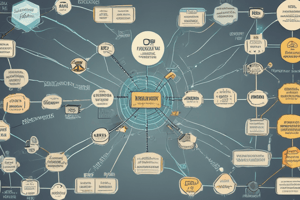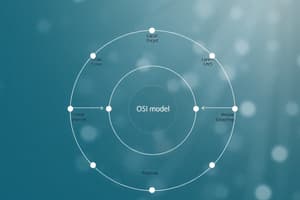Podcast
Questions and Answers
What is the main advantage of Go-Back-N ARQ protocol over Selective Repeat ARQ?
What is the main advantage of Go-Back-N ARQ protocol over Selective Repeat ARQ?
Simplifies the process at the receiver site.
Why is Go-Back-N ARQ protocol bandwidth inefficient?
Why is Go-Back-N ARQ protocol bandwidth inefficient?
Because it discards out-of-order frames and resends all frames from the damaged frame onwards.
What is the purpose of a negative ACK (NAK) in Selective Repeat ARQ?
What is the purpose of a negative ACK (NAK) in Selective Repeat ARQ?
To report the sequence number of a damaged frame before the timer expires.
In Selective Repeat ARQ, what happens when a frame is received out of order?
In Selective Repeat ARQ, what happens when a frame is received out of order?
What is the maximum size of the sender and receiver windows in Selective Repeat ARQ?
What is the maximum size of the sender and receiver windows in Selective Repeat ARQ?
What happens if the window size is larger than 2 m /2?
What happens if the window size is larger than 2 m /2?
Why is Selective Repeat ARQ more bandwidth efficient than Go-Back-N ARQ?
Why is Selective Repeat ARQ more bandwidth efficient than Go-Back-N ARQ?
What is the main disadvantage of Selective Repeat ARQ?
What is the main disadvantage of Selective Repeat ARQ?
In what situation would Go-Back-N ARQ be a better choice than Selective Repeat ARQ?
In what situation would Go-Back-N ARQ be a better choice than Selective Repeat ARQ?
What is the purpose of the receiver window in Selective Repeat ARQ?
What is the purpose of the receiver window in Selective Repeat ARQ?
Flashcards are hidden until you start studying




